Scientific Facts
| Common Name | Lilac-crowned Amazon |
| Scientific Name | Amazona finschi |
| Lifespan | 40 – 60 Years |
| Size | 12. 8 inches (33cm) |
| Body Mass | 11.3oz. (325 grams) |
| Habitat | Semi-deciduous forests |
| Native Range | The Pacific Coast of Mexico |
Information & Physical Appearance
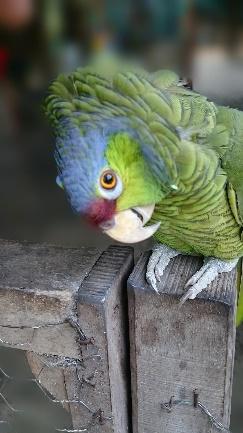
The Lilac-crowned Amazon (Amazona finschi) belongs to the order Psittaciformes, the family Psittacidae, the genus Amazona.
Other common names include Lilac-crowned parrot, Wood’s Red-fronted Parrot, Pacific Parrot, and Finsch’s Parrot.
There are a total of two races, including the nominate race, namely A.f. finschi and A.f. woodi.
Amazona finschi subspecies
1. Amazona finschi finschi – Lilac-crowned Amazon (nominate race).
Adults are not sexually dimorphic. Mature birds of both sexes have a green plumage. The feathers are edged in black.
The greenish-yellow ear coverts and cheeks do lack the edging, which is present in most of the plumage, though.
The primary feathers are dark blue in color. The secondary feathers are green in color, tipped with dark blue.
Also, the initial 1-5 secondary feathers are marked with a bright red speculum on the very edges.
The forehead, lores, and forecrown display maroon coloration, while the neck, nape, and crown exhibit nuances of blue-lilac purple.
The tail is green, and so are the wing coverts. Furthermore, the tail is tipped with yellowish.
The legs, orbital rings, as well as the beak, are pale brown-grey in color. The irises of adults are amber-orange colored, with a pale grey eye-ring.
2. Amazona finschi woodi – Wood’s Red-fronted Parrot
A.f. woodi is the rarer of the two Amazona finschi subspecies.
A.f. woodi is slightly larger than A.f. finschi. Also, it is somewhat duller in color, especially the thin frontal band, with both sexes being greener in general and less yellowish. Not the least, the forehead is visibly narrower.
Juvenile
Juvenile lilac-crowned parrots are very similar to adults. However, the immatures’ irises are dark brown in color instead of amber-colored as in adults.
Also, the eye-ring is white as opposed to pale gray as in mature lilac crowns. There are fewer maroon-colored feathers on the forehead.
Similar species
The Lilac crown resembles very closely one of its relatives, the red-crowned Amazon parrot. However, the tail of the red crown parrot is slightly longer, and there is less of the vibrant purple-lilac coloring on the crown in favor of bright red coloring.
Lifespan

The Lilac-crowned Amazon is known to live for well over 30 years on an average in captivity. With proper care, these parrots can actually manage to live up to 40 – 60 years of age.
Ecosystem & Habitat
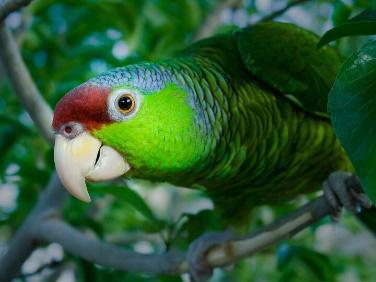
The Lilac-crowned Parrot is a native inhabitant of the Pacific coast of Mexico. It occurs in southwest Chihuahua, the southeast end of Sonora all the way to Sinaloa in the south, the west of Isthmus of Tehuantepec, Warrior, and Michoacan to Oaxaca, as well as in Colima, Jalisco, and Nairiti.
More specifically, A.f. finschi’s range spans across the southwestern to central-western portions of Mexico.
A.f. woodi’s range spans across the northwestern parts of Mexico.
Throughout most of the year, these parrots are primary residents; however, when out of the breeding season, they may also visit lowlands, e.g., the lowlands in Oaxaca.
This amazon parrot species is regarded as fairly common in southeast Sonora, and abundant in Colima, too. Lilac-crowned amazons are rather rare in Oaxaca’s highlands.
Also, in several locations across the United States, wild populations of lilac crowns of the nominate race have been reported to occur up-to-date. Nowadays, breeding populations of feral birds seem to be well-established in California.
The preferred type of habitat includes humid oak/pine forests. The species occurs at elevations of up to 6000ft. However, it is most common at elevations that do not exceed 3280ft.
Food & Diet
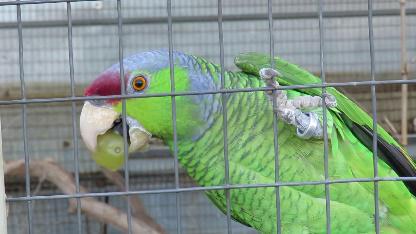
Currently, very little is known about the eating habits of lilac-crowned amazons, as these habits are still only very poorly documented. However, there are existing reports of these birds having a particular preference for figs.
The wild diet of lilac crowns varies based on the seasonal availability of food but is mainly compromised of the seeds of various canopy trees.
During the rainy season, these birds mainly feed on Esenbeckia nesiotica, Caesalpinia pulcherrima (a species of flowering plant in the pea family), Jatropha spp. (a type of flowering plant in the spurge family), Celaenodendron mexicanum, as well as Sciadodendron excelsum (aka jobo de lagarto).
During the dry season, the lilac crowns’ diet is mainly compromised of Brosimum alicastrum (aka Maya nut or breadnut), Ficus insipida (a type of tropical tree in the fig family), Astronium graveolens (a type of flowering tree in the cashew family), Comocladia engleriana, and Celaenodendron mexicanum.
These birds are locally regarded as pests throughout certain parts of their native range since they tend to cause some crop damage to bananas and corn.
Behavior
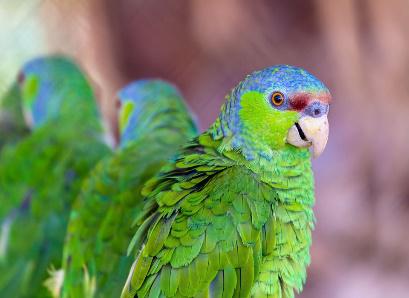
Although not migratory birds, there are reports of both longitudinal and altitudinal movements associated with food availability.
Year-round, lilac crowns are most commonly seen either in pairs or in family groups. Also, these parrots are known to form large foraging flocks.
At night, Finsch’s parrots are to return to communal roosts.
The call is described as a shrill “krih-krih.” While this is one of the most distinct calls, there are other raucous calls in these birds’ repertoires in the wild, too.
Reproduction

The breeding season begins in January and continues throughout May. These birds are known to nest in various tree hollows, such as hollows in the native Ficus trees. Old nests are also favored, e.g., the nests of woodpeckers, and so are arboreal termite mounds.
The female is to lay a single clutch per year, usually consisting of up to 3 rounded eggs measuring 1.4 x 1.1 inches (37 x 29mm).
The nesting cycle consists of 28 days of incubation of the eggs. It takes about 2 months for the young chicks to fledge.
Survival Threats & Conservation
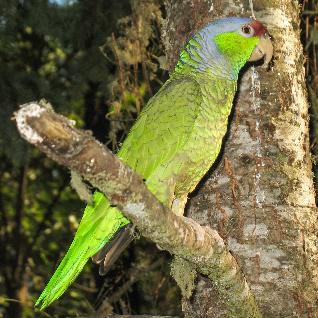
The lilac-crowned amazon is listed under the Endangered category of threatened species on the IUCN Red List. This species is considered in serious danger of extinction as the number of lilac crowns in the wild keeps decreasing very quickly.
The ongoing population decline is driven by the unsustainable exploitation of the recorded ranges, and ultimately, habitat loss.
Back in 2003, Renton and Elias estimated the global population of lilac-crowned parrots at between 10000 and 7000 individuals. Nowadays, based on the 2018 global assessment, there are between 6700 and 4700 individuals left in the wild.
Tragically, according to experts, about 5400 individuals are being caught illegally in Mexico every year.
In 2012, a drastic 72.6% decline of this species in its original distribution was reported. Ultimately, the population of this species is estimated to decline very fast.
In addition to the survival threats posed by habitat loss and the continuous illegal trapping of wild lilac crowns, the inter-annual fluctuations in rainfall which come as a result of the Pacific Ocean’s El Niño-La Niña cycle are estimated to affect adversely literally all aspects of these parrots’ reproduction. These include the size of the clutch, the growth and survival of the nestlings, the nesting pairs’ reproductive output, and, nonetheless, the survival and recruitment of the young in the wild.
All of the above beings said, there are severe implications for the potential impact caused by climate change when it comes to limiting the reproductive output of the wild populations of lilac crowns inhabiting tropical dry forests.
The major threat for lilac crowns is none other but capture for the pet trade, despite these birds being subjected to international trade control.
Despite the severe survival threats, there is no action recovery plan running up-to-date, and there is no systematic monitoring scheme.
Availability – Where to Get a Lilac-crowned Amazon
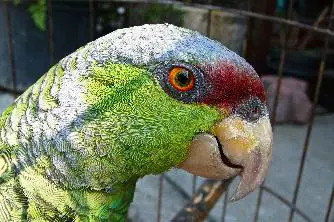
Throughout its area of distribution, the lilac-crowned parrot is very popular as a pet. Moreover, these birds have high cultural value as ornamental/pet birds because of their uniquely colored feathers.
Lilac crowns are widespread in captivity on an international level. With this in mind, these parrots are readily available, quite easy to find, and acquire from a variety of pet stores/avian-specialty stores, as well as from reputable breeders.
It is extremely important to only opt for captive-bred lilac-crowned amazons available for sale, as not to further stimulate the illegal, reckless trapping of these wild creatures.
In addition to that, lilac crowns can be adopted from avian rescue organizations. Potential adopters should better make sure to ask whether the bird has any behavioral issues, and nonetheless, why it was given up for adoption.
Interesting Facts
- One of the common names for the Lilac-crowned parrot – Finsch’s parrot – commemorates the German explorer and naturalist Otto Finsch.
- Lilac crowns have been observed feeding together with their close relatives, Amazona viridigenalis (red-crowned parrots) in California, LA.
- Due to predation, the nest success lilac crowns is rather low, about 42%. Also, there is an additional 27% mortality observed among fledglings.
- Due to habitat loss, as well as the continuous illegal capture of lilac-crowned parrots for the exotic pet trade, the wild populations have declined more than 30% over the course of the last 10 years.
- Similarly to many other parrot species, lilac crowns may also go through a particular stage of their development known as a bluffing stage, or a hormonal stage, which resembles puberty in humans. While going through their bluffing stage as they reach sexual maturity, lilac crowns may become quite difficult to handle, and for this reason, they are highly recommended only for the experienced bird owners.
- Finsch’s parrots have been kept as pets ever since the 1800s.
How to Care for the Lilac-crowned Amazon
1. Housing
Being the active creatures that they are, lilac crowns require a roomy, spacious cage in order to thrive.
Whether the owner is to provide an aviary or a suspended cage, it should measure at least 9.8ft. in length, and 2 x 4 feet in width.
The cage/aviary should be equipped with a playpen at the very top. At least one more playpen has to be provided in the owner’s home, too.
Also, daily excursions out of the cage should be provided for about 2-4 hours, and this is especially crucial in the case the birds are not housed in an aviary. As a rule of thumb, these birds require to spend time outside of their cage to be able to play freely, expand their wings, and exercise.
Always keep the bird away from any drafts. Note that lilac crowns are capable of tolerating varying temperatures.
Perches of varying texture and size should be provided, as these birds love to climb. Rougher textured perches work great to ensure easier perching, while also helping to keep the parrot’s feet and legs healthy.
Right next to a toy, a concrete perch can be placed. It is best if the concrete perch is the highest of all, perches.
Bathing is especially important for lilac-crowned amazons, as it helps to keep the feathers from drying out. Also, this is a fun time to spend with your feathery fellow.
Use a commercially available birdbath or put the part directly in the kitchen sink. Alternatively, spray your pet with warm water. Let your lilac crown friend tell you how he/she enjoys being bathed the most.
Make sure to provide a variety of toys, including both non-destructible and destructible ones, as these parrots love to chew. Wooden toys, foot toys, and push-and-pull toys are strongly recommended.
2. Cleaning & Maintenance
Basic cage care: daily cleaning and refilling of food and water containers.
All perches, toys, as well as the floor of the cage, should be washed weekly.
A full hosing down and thorough disinfection of the cage/aviary should be accomplished yearly. Old dishes and toys need to be replaced with new ones or freshened accordingly.
3. Personality
Lilac-crowned parrots are known to equally enjoy human interaction and interaction with other birds.
Once the caregiver is home, he/she should best green the parrot while walking into the room.
As a rule of thumb, the more a Finsch’s parrot pet is to spend time around people, the more socialized it will become, and hence, it will also become more willing to play and interact.
If a lilac crown pet is neglected as it grows, it will get lonely and will then get to exhibit emotional depression and/or destructive behavioral patterns.
Owners should best set aside about 3 to 4 hours every day for one-on-one interactions with their feathery fellow. This will help for a healthy, strong bond to be established over time.
Finsch’s parrots are regarded as fair talkers, fine pets, and quite dynamic creatures, as well. They are clever and affectionate, but they are also very lively, energetic, and active, so they need to spend a good portion of their time engaged in social activities and play outside the cage.
4. Handling
This amazon parrot species is known to adapt rather quickly, and in fact, rapidly becoming well-accustomed to its new keeper and new environment. Once better accustomed to the keeper/environment, training can begin.
Make sure to allow a newly-acquired lilac crown to get used to your voice and its cage before any attempts for handling it.
Note that babied that have been hand fed will not require much taming, and will often willingly allow being handled straight away since they are well-used to human attention.
5. Exercise
Despite being a fairly active amazon, the lilac-crowned parrot pet is prone to obesity. Therefore, providing plenty of opportunities for daily exercise is crucial.
Climbing is one of the most favorite activities of lilac crowns, and they have the reputation of funny, curious acrobats. A variety of perches and toys will help to keep your pet busy, entertained, and happy.
6. Breeding
Breeding Lilac-crowned parrots in captivity is not an easy task and should be only reserved to experienced bird owners/breeders.
Lilac crowns become sexually mature once they turn 5 years of age. In order for a pair to breed successfully, the mates have to be already bonded with each other into a harmonious pair.
A nest box measuring 31″-39″ in height has to be provided. The nest box should feature a 4’’ – 5’’ opening and should be 12’’ – 14’’ in diameter on the inside.
On the bottom of the nest box, soft bedding material should be placed.
7. Possible Health Issues
Lilac-crowned amazons have a solid reputation for becoming ill quite rarely, mostly if not solely in the case that they have not been taken proper care of.
The most common conditions that tend to affect lilac crown pets include obesity, Chlamydiosis, Polyomavirus, and Vitamin A deficiency.
To counterfeit possible obesity issues, pay attention to the type and amount of food offered on a daily basis.
Vitamin A deficiency can be easily avoided when an adequate diet is provided.
Chlamydiosis’ symptoms include nasal discharge, fluffed feathers, and low appetite.
Polyomavirus’ symptoms include weight loss, anorexia, and lethargy.
Important Note
If the caregiver is to notice any signs of possible illness, the lilac crown pet should be placed in a warm, secure, draft-free environment as soon as possible. Food and water should be placed close to the perch to ease accessibility, and an avian veterinary should be contacted immediately
8. Diet
Ensure a high-quality pelleted diet. The pelleted diet should be supplemented daily with fresh, bird-safe fruits and veggies, as well as seed mixes.
Some of the suitable fruits that should make up to 30% of the diet include but are not limited to pomegranate, apples, oranges, bananas, cactus fruits, figs, pears, apples.
Some of the veggies to feed to your lilac crown include but are not limited to green peas, carrot, celery, fresh corn, and beans, as well as green leaves like lettuce, chickweed, sowthistle, Swiss chard, and dandelion.
Complete kibble is a must.
FAQ Section
How Long Do Lilac-crowned Amazons Live?
With proper care, love, and attention, Lilac-crowned Amazons can live for about 60 years in captivity.
Which Country is the Lilac-Crowned Amazon Indigenous to?
Amazona finschi, the lilac-crowned amazon, is a parrot species indigenous to the Pacific slopes of Mexico.
Are Lilac-Crowned Parrots Good Talkers?
Lilac-crowned amazons are regarded as fair talkers, yet they are not as renowned talkers as other amazon species, such as the yellow-naped amazon. However, lilac-crowned amazons are fully capable of learning an impressive, large vocabulary of phrases and words alike when provided with proper training.
Are Fincsh’s Parrots Noisy?
The Finsch’s Amazon or the Lilac-crowned amazon is known to be quite noisy early in the morning, as well as at sunset, yet it is not considered among the noisiest parrot pets. While these parrots can become particularly noisy during certain hours of the day/afternoon, their loud symphony of calls typically lasts for only about 10 minutes.
Are Lilac-crowned Amazons Endangered?
Yes, lilac-crowned amazons are endangered with extinction. Amazona finschi is listed as Endangered on the IUCN Red List of Threatened Species, with only as few as between 6700 – 4700 individuals remaining in the wild based on the August 2018 global assessment.
Do Lilac-Crowned Amazons Make Good Pets?
Lilac-crowned amazons can make good pets, as long as the caregiver is willing to put in the needed time, efforts, love, and attention. As compared with other amazon parrots, lilac-crowned amazons are considered much less prone to aggressive behavior, and instead, they are regarded as gentler species with quiet manners, and playful, active, social, affectionate temperament.
How to Care for the Lilac-crowned Amazon?
To take the best care for the lilac-crowned amazon, owners want to provide a spacious cage/aviary, a variety of toys, a balanced diet, and, nonetheless, plenty of one-on-one interaction on a daily basis. Lilac crowns have to be kept away from drafts, and they should ideally receive the much-needed attention, mental stimulation, and daily socialization in order to become tame, cheerful, and to remain happy and healthy.



